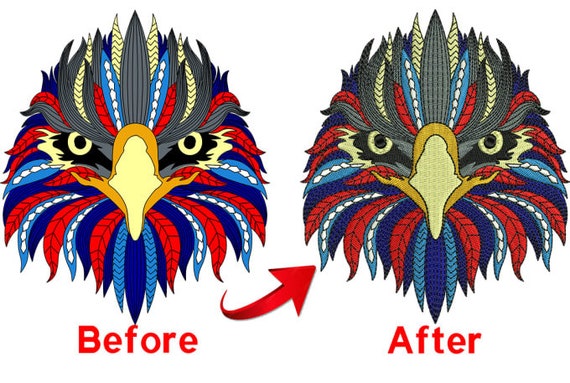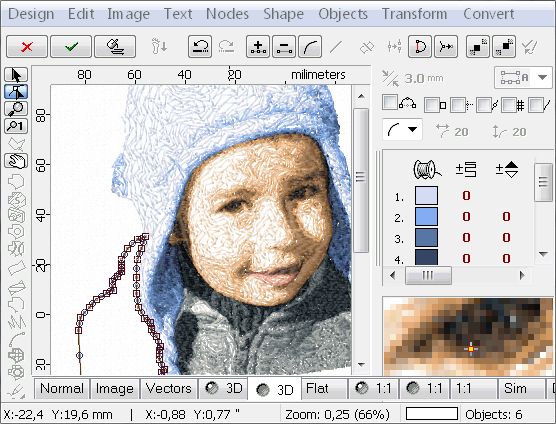Professional Digitizing for Embroidery: Quick and Reliable Service
Wiki Article
Mastering the Needlework Digitizing Process: Your Ultimate Guide
Embroidery digitizing is a precise craft that needs precision and expertise to convert elaborate designs into electronic styles for equipment embroidery. As craftsmens begin on this trip to understand the embroidery digitizing process, a comprehensive understanding of the fundamentals establishes the foundation for quality.
Comprehending Needlework Digitizing Essentials
Needlework digitizing essentials develop the structure whereupon intricate designs are converted right into machine-readable styles for exact sewing. This initial step in the needlework digitizing procedure is essential for making certain that the last stitched product is a faithful depiction of the original layout. Comprehending embroidery digitizing basics entails realizing crucial principles such as stitch types, stitch direction, thickness, rug, and pull compensation.Stitch kinds play an essential function in figuring out the visual and textural outcome of the stitched layout. By picking the proper stitch type, whether it be satin, fill, or running stitch, digitizers can accomplish the desired effect and boost the general high quality of the embroidery. Additionally, stitch instructions affects the flow and dimension of the design, while thickness figures out the spacing and protection of the stitches.
Additionally, underlay sewing supplies stability to the design by safeguarding the textile and protecting against distortion throughout the needlework procedure. Pull payment is one more necessary factor to consider to combat the natural propensity of material to agreement when sewn. Understanding these needlework digitizing essentials is fundamental for developing professional-quality stitched products.
Choosing the Right Digitizing Software Application
Selecting the ideal digitizing software is an important decision that significantly influences the effectiveness and high quality of the embroidery digitizing procedure. Digitizing for Embroidery. When choosing the appropriate digitizing software application, it is necessary to take into consideration elements such as the complexity of styles you intend to create, the user-friendliness of the software application, the degree of client assistance supplied, and the compatibility with your embroidery equipmentThere are numerous digitizing software application options readily available out there, ranging from standard programs for beginners to innovative software for expert digitizers. Some popular selections include Wilcom EmbroideryStudio, Hatch Needlework Software, and PulseID. These software program packages use a large range of devices and functions to aid you create complex styles with simplicity.
Prior to making a decision, it is recommended to check out the various software options with free tests or demonstrations to establish which one ideal fits your requirements. Additionally, reviewing reviews and looking for suggestions from skilled digitizers can supply useful understandings into the toughness and weaknesses of each software (Digitizing for Embroidery). By meticulously reviewing your requirements and contrasting the attributes of various digitizing software program, you can make an informed option that boosts your needlework digitizing process
Digitizing Devices and Strategies

Optimizing Style Settings for Needlework
Grasping the details of layout setups is basic in achieving optimum cause the embroidery digitizing process, building upon the foundation laid by understanding digitizing tools and techniques. When optimizing design setups for needlework, it is necessary to take into consideration variables such as stitch kind, thickness, rug, pull payment, and enrollment. Sew type choice impacts the overall look of the style, with choices like satin, fill, and running stitches providing different textures and impacts. Thickness describes the spacing and density of stitches, impacting the design's coverage and durability. Correct underlay sewing gives stability and prevents textile distortion, particularly for complex layouts or on elastic materials. Draw payment adjusts for textile stretch during sewing, making certain precise design duplication. Enrollment settings straighten different components of the style accurately, keeping navigate to this site total layout stability. By fine-tuning these layout settings, embroiderers can boost the high quality and precision of their stitched creations.
Troubleshooting Common Digitizing Issues
When experiencing usual digitizing problems throughout the embroidery procedure, it is vital to recognize the origin causes and apply efficient solutions without delay. One typical trouble is stitch density issues, where stitches might be too thick, creating the material to tighten, or too thin, resulting in gaps in the style. Adjusting the stitch density settings in the digitizing software program can help fix this concern.Another regular obstacle is string breaks throughout the embroidery process. This can happen as a result of numerous reasons such as incorrect stress settings, boring needles, or utilizing low-grade string. Ensuring proper maintenance of the embroidery maker, consisting of regular needle changes and tension adjustments, can reduce the incident of string breaks.
In addition, design registration errors can result in misaligned elements within the embroidery style. Inspecting the layout alignment in the digitizing software application and making needed changes before sewing can aid in avoiding this issue. By dealing with these typical digitizing concerns quickly and properly, you can make sure a smoother needlework procedure and top quality ended up items.
Conclusion
To conclude, grasping the needlework digitizing procedure needs a solid understanding of the basics, the right option of software application, and sites expertise of devices and techniques. Maximizing style setups and fixing typical digitizing concerns are vital action in making certain top notch needlework outcomes. By adhering to these steps diligently, one can attain accuracy and effectiveness in the digitizing process.Report this wiki page